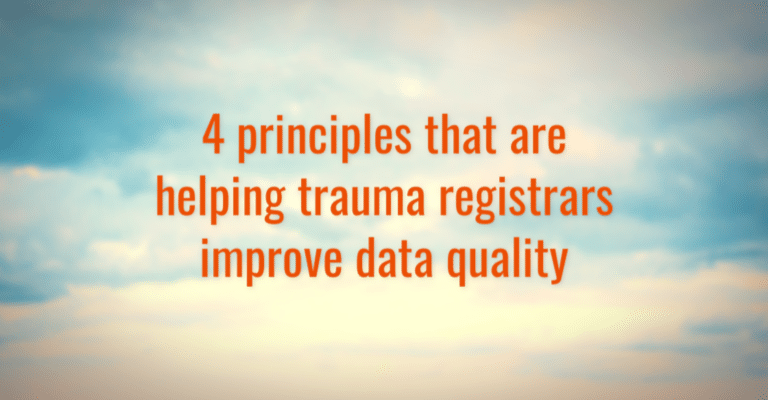High-quality data is essential to running a trauma center. While data quality depends on many factors, well-trained trauma registrars play a critical role. In my experience, the best registrars are the ones who have learned the unique thought processes of effective data abstraction.
These thought processes take some time to master, but understanding the basics is easy. The following four principles can help trauma registrars improve data quality by making sure their work is accurate, detailed and consistent.
1. Understand and observe data hierarchies
This is one of the basics, but it is absolutely critical to data quality. When reviewing trauma registry reports, I often find that different registrars are collecting the same data element from different data sources. The problem is that this introduces data variation and reduces data quality.
To avoid this problem, trauma registrars should master the data hierarchies detailed in the National Trauma Data Standard (NTDS) Data Dictionary.
A data source that is the “gold standard” for one data element might be secondary for another. For example, the NTDS dictionary specifies that the primary data source for ED/hospital arrival time is the triage/trauma flow sheet. In contrast, the primary source for injury incident time is the EMS run report. Registrars should look in the trauma flow sheet for incident time only if it is unavailable in prehospital documentation.
2. Follow NTDS instructions carefully
While NTDS definitions are very specific, some can be confusing. Many problems are created when trauma registrars miss the special instructions and clarifications contained under “additional information.”

For a good example, let’s return to ED/hospital arrival time. Some registrars interpret this to mean the time the patient is admitted to the hospital. According to the NTDS dictionary, however, hospital admit time should be used for this data element only when the patient is admitted directly to hospital. If a patient is brought to the ED, the “hospital arrival time” is the ED arrival time.
Here’s a more challenging example — hospital discharge disposition. Say a patient came to a trauma center from a skilled nursing facility (SNF) and is being discharged to the same SNF. The discharge disposition is the SNF, right? Not necessarily.
The key is to understand the underlying logic of the definition. The NTDS dictionary specifies that “home” refers to “the patient’s current place of residence (e.g., Prison, Child Protective Services etc.)”. While the dictionary does not mention SNFs explicitly, it is clear that “home” refers to any facility where a patient normally lives. If a patient came from a SNF and is being discharged to the SNF, they are being discharged to home.
Developing a better understanding of NTDS definitions will often enable a more complete abstraction. For instance, registrars often leave injury incident time blank because they know they cannot create their own estimate based on things like the 911 call time. However, the additional information section specifies that injury incident time estimates can be based on “report by patient, witness, family, or health care provider.” This information is often available in the narrative of the electronic patient care report from EMS.
While it is true that registrars should not create an injury time based on EMS dispatch time, it can often be found by registrars who understand the definition and know where to dig.
3. Use the most specific code available
Another familiar problem is using a generic code when a more specific code exists. This is more common among new registrars, but certain injuries are challenging for everyone. The solution is to pay close attention to AIS and ICD-10 descriptions and develop the habit of drilling down as far as possible for the most accurate code.
For example, registrars often use AIS code 161000.1 (Cerebral Concussion, NFS) for trauma patients who have suffered head injury. While this code indicates the concussion, it does not convey anything about possible loss of consciousness. Registrars who go a little deeper into the code set will find several more descriptive codes that may be appropriate. In many instances, a more specific AIS code will yield a more accurate ISS score, which leads to a more accurate TRISS score.
Registrars should be aware that the ICD-10 codes used by billing may be different from the codes preferred for the trauma registry. If two similar codes exist for the same procedure, billing staff will typically use the code linked to higher reimbursement. Yet the alternative code might be more descriptive of the episode of care. Entering the more descriptive code in the trauma registry will yield more useful trauma data.
4. Understand how your database is structured
Trauma registrars who understand how their registry system captures and uses data will be able to provide better inputs.
For example, newer registrars are often unsure how to enter vital sign data. Since a set of vitals is usually collected over the course of several minutes, learners will often enter individual vitals as separate entries. The problem is that in many registry software systems, this approach will make it impossible for the system to auto-calculate scores such as the Revised Trauma Score (RTS).
The key to avoiding this mistake is to understand how your system uses raw data to generate risk scores and other metrics. In the example above, this approach will help the registrar understand that it is OK to record a single time for a set of vital signs even though they were actually taken over several minutes.
A solid understanding of database structure is also invaluable for correctly documenting incomplete data. For example, some systems allow null values to be entered in any data field while other systems require certain data fields to be left blank if not located.
Time data is another example. Some registry systems collect time data as actual times (like 08:15 or 21:30) and do not allow text entries in time fields. Other systems collect time data as part of a string of characters, so null value text entries such as “not known/not recorded” are permitted. Again, understanding how the database is structured will help registrars enter the most usable information.
Trauma registrars sometimes enter “00:00” for times that cannot be found. This is a mistake. The key is to understand that 00:00 means midnight. Using 00:00 as a fill-in value for “unknown time” will create problems in the data and alter key calculations such as length of stay.
One final data structure tip: Never enter “0” in a number field unless the data value is actually 0. If the information you are looking for is not available, leave the field blank or enter the appropriate null value as required by your system.
Craig Rees is product manager at ImageTrend.
ImageTrend Patient Registry is a web-based, multi-discipline registry solution that collects and analyzes trauma, stroke and cardiac data. Dynamic forms allow you to gather information more efficiently. State-of-the-art integrations with EMS systems and the hospital EMR enable increased collaboration across the continuum of care. Advanced reporting helps your department take performance to the next level. The system’s scalable architecture and relational database make it perfect for stand-alone hospitals, large healthcare networks, and regional care systems. Find out more at ImageTrend Patient Registry.

